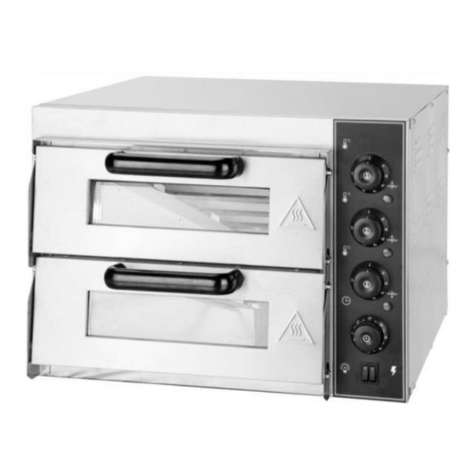
3
USER SAFETY
The appliance is intended for professional use in institutional and professional kitchens and must only be
used by skilled personnel who have been trained on its proper use. For safety reasons the appliance
must be supervised during operation.
The appliance is not intended to be used by children and/or persons with impaired physical, sensory or
mental abilities, or who lack experience or knowledge, unless they are supervised by a person
responsible for their safety, or who has been instructed on using the appliance.
In the event of failure or poor operation, switch off the appliance, close the water supply cock,
disconnect the power supply and contact an authorised Technical Support Centre.
This appliance shall be used only for the purposes for which it was designed, meaning for all types of
baking of pastries, baked goods and food: fresh and frozen; for reconditioning chilled and frozen food,
for steam cooking meats, fish and vegetables. Any other use is considered improper.
The noise level of the appliance in operation is less than 70 dB (A).
INFORMATION FOR THE USER
When the appliance is used for the first time it is recommended to run an empty cycle for 40/50 minutes
at a temperature of 220/230°C. In this way all unpleasant yet fully normal smells due to heating the
thermal insulation enveloping the cooking chamber and the silicone used for its external sealing are
dissipated.
Avoid prolonged permanence on the steel surfaces of foods containing acidic substances (lemon juice,
vinegar, salt, etc.) which cause corrosive deterioration.
The appliance must be cleaned regularly, even daily, to ensure the best functionality and to extend its
service life.
If specific detergents (degreasers) are used for cleaning stainless steel, ensure they do not contain
corrosive acid substances (no presence of chlorine even if diluted) or abrasive substances. Carefully
follow the instructions and warnings of the detergent's manufacturer and take precautions such as
using adequate rubber gloves.
Strictly avoid using scouring pads, steel wool and scrapers that may ruin the treated surfaces.
COOKING TIPS
In placing the food in the cooking chamber, maintain a space of at least 40 mm between trays
in order not to excessively obstruct air circulation.
Do not use trays with sides higher than necessary: the sides form barriers that prevent hot air
circulation.
Preheat the oven every time before cooking to achieve top performance.
For cooking as consistently as possible, spread the food evenly in every tray taking into account
its size, layer or thickness.
Avoid adding salt to food in the cooking chamber.
To check correct progress of the cooking cycle use the chamber's internal lighting: avoid
uselessly opening the door, which causes wastes of energy and longer cooking times.
RESIDUAL RISKS
After baking open the door with caution, to avoid the violent outflow of heat which might cause burns.
During oven operation pay attention to hot areas of its outer surfaces (marked on the appliance).
Do not use the door handle to move the appliance (possible glass breakage).
The supporting bench must be able to withstand the weight of the machine and house it correctly.
The appliance is fitted with electrical parts and must never be washed with a water or steam jet.
The appliance is electrically connected: disconnect the power supply before performing any type of
cleaning.
To avoid incorrect connections of the appliance, the relevant electrical/water connections are
marked on the appliance by suitable identification plates.




























